Collaboration with Thailand
In February 24, 2016 a new “Memorandum of Understanding” (MOU) was concluded between NITE and the National Center for Genetic Engineering and Biotechnology (BIOTEC).
BIOTEC was established at Thailand Science Park in 1983 to promote sustainable development for the people of Thailand. While operating a major microbial Biological Resource Center (BRC) named BIOTEC Culture Collection (BCC), BIOTEC contributes to the implementation of the Nagoya Protocol on Access to Genetic Resources and the Fair and Equitable Sharing of Benefits and related regulations in Thailand.
The objective of the collaboration is to promote Parties’ cooperation in biotechnology based on the principle of equal rights, reciprocity and mutual advantages.
From 2005 to 2012
Based on the first MoU concluded in 2005, NBRC and BIOTEC initiated two projects to exchange bilogical resrouces (PA1) and to explore new resources in Thailand (PA2). In PA1, BIOTEC and NBRC exchanged approx. 110 strains of fungi (mainly Cordyceps and related species; insect fungi) In PA2, 6 subprojects were camed out upon completion of the projects, the findings were published and the collected strains were made available from NBRC and BCC.
BRCs Cooperation Projects with Thailand
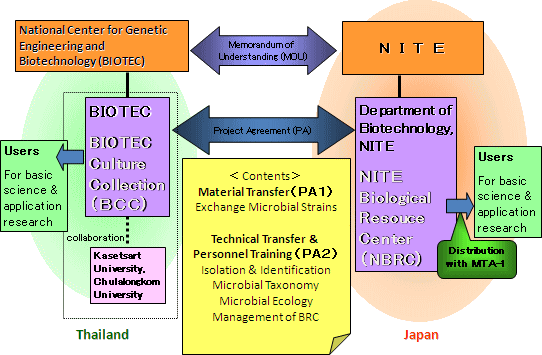
Subproject 1
Acetic Acid Bacteria
Acetic acid bacteria are utilized to produce acetic acid and/or cellulose. Their bacterial cellulose are important for food and industrial products.
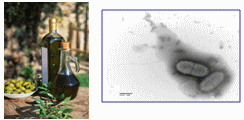
Subproject 2
Xylariaceae (fungi)
The species of this ecological group are genetically diverse and morphologically unique, and have potential to produce new industrial compounds. .
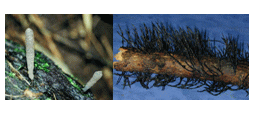
Subproject 3
Yeasts in Nature
Yeasts are used for fermentation of foods such as alcohol and model organisms in genetic engineering.
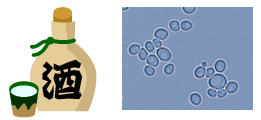
Subproject 4
Lactic Acid Bacteria from fermented foods
Lactic acid bacteria are utilized for food fermentation such as yogurts, lactic beverages etc. and contribute to human health.

Subproject 5
Aero-aquatic Fungi
The group is hoped as resources for new industrial substances, that adapted to freshwater environment and have unique shape and lifestyle.

Subproject 6
Yeasts for Biofuel
Biofuel has come to the forefront for energy security and environment conservation, and yeasts are focused on the function of alcohol fermentation from biomass.
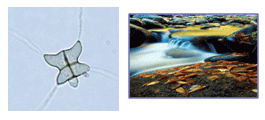
From 2012 to 2015
Outline of the Curator Program
- NITE and BIOTEC jointly organized the “Curator* Course Program for Microbial Resource Management” which was conducted from 2012 to 2015. The program aimed to develop professional curator skills for the 15 trainees from Thailand by enhancing their capabilities in proper handling and management of microbial resources. Trainees gained knowledge and techniques through on-the-job training (OJT) and each of them worked with NBRC researchers to complete the research on a specific theme.
*A curator is a specialist in charge of the culture collection and is responsible for the preservation and quality control of strains, data management of strains, and distribution of the strains to users. They play a vital role in sustaining major function of the culture collection.
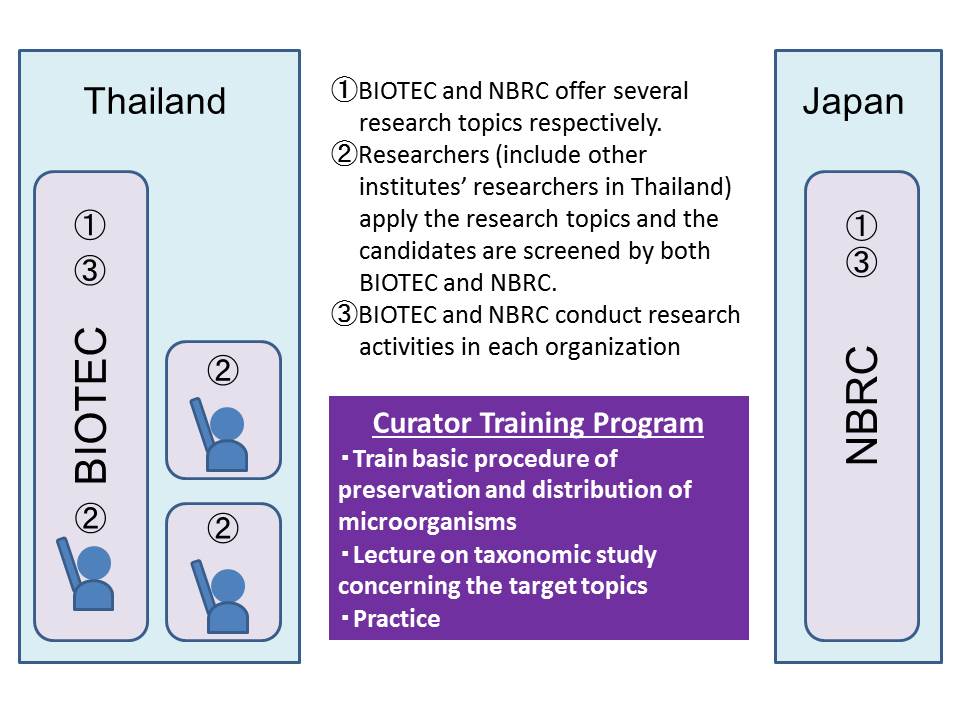
A schematic diagram of the curator course program
Results
2013
| No. | Research Topics | Results |
| 1 | Survey neo-type/new authentic specimens and isolations of Cordiceps, its allies in Japan | Cordyceps were collected from various environments in Japan for identification and classification analysis and the necessary skills were acquired through the training. The selected six strains are registered at NBRC and now available for distribution. |
| 2 | Peptide mass fingerprinting for identification of Saccharomyces yeasts using MALDI-TOF MS | The MALD/TOF MS method for the identification of yeast species was evaluated. The advantages as well as the difficulties of using the method were determined, and thus improvements were suggested regarding the protocols and techniques of the MALDI/TOS MS method. |
| 3 | Basic study of algae and its preservation | Basic data were collected to determine long-term preservation methods which can be applied to the microalgae strains currently preserved in NBRC. Furthermore, the strains in which the cryopreservation method could be applied were determined. |
| 4 | Identification and characterization of microorganisms in the genus Chitinophaga | Identification analysis of a new strain (thought to be a candidate of a new Chitinophaga species) was performed using the polyphasic taxonomy approach. The NBRC strains formerly classified in Chitinophaga arvensicola were re-classified using the same method. The new strain candidate is to be made available as a NBRC strain when ready. |
| 5 | Survey of marine chytrids and fungal-like organisms in Japan | Chytrids and fungal-like organisms collected from marine environments of Japan were isolated and identified. The identified strains are to be registered and to be made available as NBRC strains when ready. |
| 6 | Current status of Thai regulations which are involved in Nagoya Protocol on Access to Genetic Resources and the Fair and Equitable Sharing of Benefits Arising From Their Utilization to the Convention on Biological Diversity | A comprehensive study was performed to deepen understanding regarding the national laws that regulate the management of bioresources in Thailand as well as the current procedures to access Thailand's microorganisms. |
2014
| No. | Research Topics | Results |
| 1 | Study and analysis of legal aspects of implementing the Nagoya Protocol on Access and benefit-sharing for utilization of microorganisms | ABS-related national regulations of Thailand were studied and knowledge regarding trends on the topic of utilization of genetic resources was shared. The new international system for the transfer and exchange of microbial strains was discussed. |
| 2 | Isolation and characterization of lactic acid bacteria in Japanese fermented foods | Lactic acid bacteria found in Japanese fermented food were collected, and 35 strains were made available to NBRC users. An analysis was performed to propose a new candidate strain as a novel species. |
| 3 | Isolation and selection of the oleaginous yeast strains and optimization of lipid production conditions | The yeast genus Lipomyces characterized with high lipid productivity were preferentially collected, and five novel species and 23 strains belonging to genera Lipomycetaceae were identified. Lipid yeast and the novel strain candidate were analyzed for lipid productivity and fatty acid profiles. 44 strains are registered as NBRC strains. |
| 4 | Evaluation of bacterial community structures in various environments in Japan: the comparison of DNA extraction and PCR methods | It became apparent that when evaluating bacterial community structures using the next-generation sequencing method, prior preparation methods (DNA extraction, PCR, etc.) greatly affect analysis results. Therefore the need to avoid comparison of data that uses different prior preparation methods as well as the importance to standardize these methods were pointed out. |
| 5 | Phylogenetic relationship of Dactylosporangium species using genome sequencing data | Observation/modification of genome sequences and the phylogenetic analysis of various Actinomycetes including the genus Dactylosporangium were performed, thus contributing to the determination of the phylogenetic relationship of the Dactylosporangium species. |
2015
| No. | Research Topics | Results |
| 1 | Comparative metagenomic for phylogenetic and functional analysis of fecal microbial communities in mammalian | The analysis of microbial communities in mice feces using the new sequencing method was optimized, and the difference between wild-type and experimental mice was observed. Results showed a difference in microbial communities between the samples collected at different hours, thus suggesting the need for a standardized research method. |
| 2 | In vitro isolation and cryopreservation of arbuscular mycorrhizal fungi and production of transformed root organs | Research was performed to consider in vitro culture of arbuscular mycorrhizal fungi (AMF), which are soil fungi that contribute to the primary production of terrestrial plants. Successful cryopreservation of in vitro AMF suggested the potential of in vitro strains to be preserved as NBRC strains. |
| 3 | Diversity of lipid production in Labyrinthulomycetes | A comprehensive analysis on Labyrinthulomycetes, which have been targeted for industrial use because of their high lipid productivity, was carried out using NBRC strains and were characterized based on growth characteristics and fatty acid profile. Information regarding these strains will be made available to NBRC users soon. |
| 4 | Thermophilic fungi in compost and the enzymatic characterization for biomass utilization | A new method for the isolation of thermophilic fungi which are potential sources to produce enzymes in industrial applications was reviewed . A variety of thermophilic biomass degradation fungal strains was collected, and efforts are being made to analyze the enzyme group of the isolated strains to reveal further use and applications. |
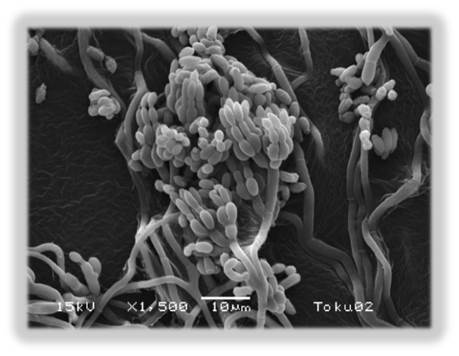
Metarhizium cylindrosporum NBRC 111629
Isolated in the program then registered as a NBRC strain for distribution
Contact us
- CBD Administration Division, Biological Resource Center, National Institute of Technology and Evaluation
-
Phone number:+81-3-3481-1963
Address:2-49-10 Nishihara, Shibuya-ku, Tokyo 1510066, Japan MAP
Contact Form


